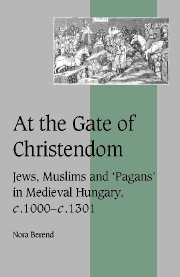Book contents
- Frontmatter
- Contents
- List of maps
- Acknowledgements
- List of abbreviations
- INTRODUCTION
- 1 HUNGARY: A FRONTIER SOCIETY
- 2 CHRISTIANS AND NON-CHRISTIANS
- 3 THE LEGAL POSITION OF HUNGARY'S NON-CHRISTIAN POPULATION
- 4 NON-CHRISTIANS IN HUNGARIAN ECONOMY AND SOCIETY
- 5 CONFLICTS BETWEEN THE PAPACY AND THE KINGS
- 6 CHRISTIAN PERCEPTIONS AND ATTITUDES
- 7 NON-CHRISTIAN COMMUNITIES: CONTINUITY, TRANSFORMATION, CONVERSION AND ASSIMILATION
- CONCLUSION
- Appendix 1 Hungarian kings of the house of Árpád
- Appendix 2 Toponyms, with Latin and German equivalents
- Appendix 3 The manuscript tradition of the Synod of Buda (1279)
- Bibliography
- Index
- Cambridge Studies in Medieval Life and Thought Fourth series
2 - CHRISTIANS AND NON-CHRISTIANS
Published online by Cambridge University Press: 06 January 2010
- Frontmatter
- Contents
- List of maps
- Acknowledgements
- List of abbreviations
- INTRODUCTION
- 1 HUNGARY: A FRONTIER SOCIETY
- 2 CHRISTIANS AND NON-CHRISTIANS
- 3 THE LEGAL POSITION OF HUNGARY'S NON-CHRISTIAN POPULATION
- 4 NON-CHRISTIANS IN HUNGARIAN ECONOMY AND SOCIETY
- 5 CONFLICTS BETWEEN THE PAPACY AND THE KINGS
- 6 CHRISTIAN PERCEPTIONS AND ATTITUDES
- 7 NON-CHRISTIAN COMMUNITIES: CONTINUITY, TRANSFORMATION, CONVERSION AND ASSIMILATION
- CONCLUSION
- Appendix 1 Hungarian kings of the house of Árpád
- Appendix 2 Toponyms, with Latin and German equivalents
- Appendix 3 The manuscript tradition of the Synod of Buda (1279)
- Bibliography
- Index
- Cambridge Studies in Medieval Life and Thought Fourth series
Summary
Medieval encounters with non-Christians took many forms. On the frontiers of Christendom, warfare was combined with peaceful contacts and interaction; a striking example of this is the case of Frankish knights in the east, some of whom learned Arabic and adopted local customs by the second or third generation. The types of contacts were also influenced by the relative position of non-Christian groups; they lived outside Christendom, they were newcomers to it as converts, or they lived within Christian Europe. Hungary's non-Christians moved from within Christian Europe or from outside Christendom, and some of them became Christians. Their story can be told only in the wider context of Christian–non-Christian interaction in medieval Europe.
CHRISTIANITAS AND NON-CHRISTIANS
If we are to understand the position of medieval non-Christians, we have to take into account contemporary notions of Christianitas. The concept took on a variety of meanings during the Middle Ages. Used to denote a set of beliefs and adherence to them (that is, in opposition to Judaism), it acquired social and communal meanings, especially beginning in the ninth century. Christianitas was sometimes a synonym for the Church, but also, rather than referring either to the Church or to the empire, it came to mean the collectivity of the populus Christianus as a social and temporal, as well as spiritual unity. A geographic idea of Christendom also developed; the territorial connotations of Christianitas appeared in the ninth century.
- Type
- Chapter
- Information
- At the Gate of ChristendomJews, Muslims and 'Pagans' in Medieval Hungary, c.1000 – c.1300, pp. 42 - 73Publisher: Cambridge University PressPrint publication year: 2001
- 1
- Cited by



